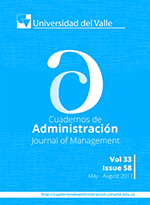Analysis of construction projects stakeholders from corporate social responsibility
Keywords:
Gestión de stakeholders, Gerencia de proyectos, Construcción, Responsabilidad social empresarial, gestión de riesgosMain Article Content
The aim of the article is to present the Stakeholders’ analysis of housing construction projects from a corporate social responsibility approach and based on the application of the Stakeholder Circle methodology, complemented with some matrixes related to risk management, and using the MicMac software of structural analysis model. The proposal is theoretically based on the topics of project management, corporate social responsibility, and stakeholder management. The methodology developed began with consultations to project managers and/or construction companies managers, using a semi-structured interview, along with the performance of documentary analysis; the consolidated stakeholder identification matrix was then constructed; later the risk matrix and response planning, on the basis of which input variables were configured to the structural analysis model, to obtain the Indirect Influence Matrix and the Direct Influence Matrix, in addition to the Displacement Plane; then, according to previous results, the different stakeholders were classified; and finally, actions and strategies were proposed for key stakeholders. The main result is that key stakeholders are: community, company Chairman, project management team, and clients. The main conclusion is related to the importance of establishing actions and strategies for these stakeholders, due to their involvement in the optimization of the system, based on the establishment of permanent challenges, given their high mobility and high dependence.
Downloads

This work is licensed under a Creative Commons Attribution-NonCommercial-NoDerivatives 4.0 International License.

